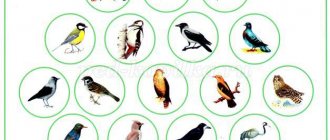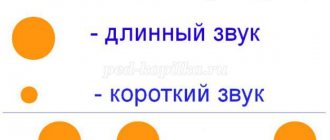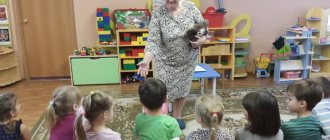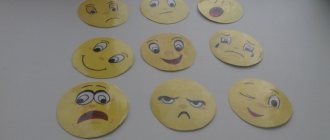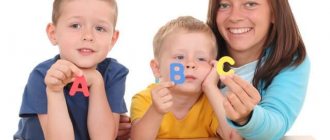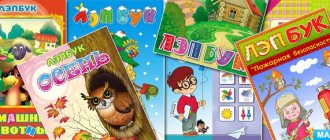Multifunctional teaching aids
Svistunkova Elena
Multifunctional teaching aids
Multifunctional teaching aids.
Educator. Svistunkova E. P.
The benefits that will be discussed can be used in working with children of older preschool age.
Didactic manuals “Uniprism”, “Unicubes”, “Flower - seven-colored”. These benefits can be used in joint activities, in individual work with children, in independent activities.
The purpose of using didactic aids is to increase children's interest in acquiring knowledge about the environment. Develop mental and creative abilities, coherent speech.
The main advantages of the benefits:
- “Uniprism”, “Unicubes”, “Flower - seven-colored” are multifunctional, easy to manufacture, easy to use;
— Develop children’s mental and creative abilities;
- They are a bright element of the subject-development environment.
— Preschoolers can help the teacher in making such aids. Any older preschooler can carefully cut and paste a picture. Children play with such aids with great pleasure, because they are made with their help.
— Thanks to such manuals, you can consolidate previously acquired knowledge in a playful way.
Didactic game “Expedition in the footsteps of literary works. Meeting hardworking heroes."
Target. To form a value-based attitude to communication, moral actions, reflection of value guidelines, and a model of ethical behavior. To consolidate the genre features of a fairy tale, story, poem.
Material. Pictures for folk, foreign, and author's fairy tales, poems, stories.
1st side of the prism - folk tales: “Tops and Roots”, “Turnip”, “Seven Semyons - Seven Workers”, “Winter House”.
2nd side of the prism - author's fairy tales: Odoevsky “Morozko”; S. Ya. Marshak “The Three Little Pigs”, “Twelve Months”; C. Perrault “Cinderella”.
Side 3 - poems: E. Blaginina “Don’t stop me from working”; V. Mayakovsky “Who to be”; M. Smirnova “The Dressmaker”; Y. Tanina “On the Water”; fable by I. A. Krylov “The Dragonfly and the Ant”.
Side 4 – stories: V. Sukhomlinsky “Grandma and Petrik”; “Every person should”; "The Baker and the Tailor"; A. Musatov “How bread came to the table”; V. Oseeva “Sons”.
Multifunctional manual "Unicubes"
The manual consists of a base - a wooden circle, at the base of which there is a rod. There are 2 rotating cubes on the rod. Each side of the cube is a different color. The cubes rotate freely.
This manual may include tasks and exercises in all areas of educational activity: “Cognitive development”, “Speech development”, “Social and communicative development”, “Physical development”, “Artistic and aesthetic development”.
Didactic game “The most, the most.”
Target . Expand children's understanding of different professions. Encourage children to independently determine which professions fit this or that definition. Activate, update, enrich the vocabulary with adjectives. Develop speech and attention.
Material. Cards with images of people, different professions:
- the greenest profession: forester;
- the sweetest profession: beekeeper;
- the reddest profession: firefighter;
- the whitest profession: doctor;
- the bluest profession: astronaut, etc.
Multifunctional manual “Flower - seven-colored”.
The manual consists of 7 petals of different colors and a circle - the middle of the flower.
This manual may include tasks and exercises in all areas of educational activity: “Cognitive development”, “Speech development”, “Social and communicative development”, “Physical development”, “Artistic and aesthetic development”.
Didactic game “Journey through the fairy tales of A. S. Pushkin.”
Target. Activate and enrich the vocabulary on the topic “Tales of A. S. Pushkin.” Develop monologue and dialogic speech. Determine the name of a fairy tale by the beginning (end, tell the fairy tale by the beginning (by the end, by the presented fragment). Cultivate a love for the fairy tales of A. S. Pushkin.
Material. Pictures for fairy tales by A. S. Pushkin.
Multifunctional manual “Magic Circles”.
The manual consists of a base - a wooden square, at the base of which there is a rod. There are 4 rotating circles on the rod. Each circle is divided into sectors of different colors. The circles rotate freely without touching each other.
This manual may include tasks and exercises in all areas of educational activity: “Cognitive development”, “Speech development”, “Social and communicative development”, “Physical development”, “Artistic and aesthetic development”.
Didactic game "Little Housewife"
Target. Expand children's understanding of the variety of food products. Encourage children to independently determine what products are needed to prepare a particular dish. Develop speech and attention.
Material. Food cards:
- cabbage, carrots, peppers, onions - necessary for cooking cabbage soup;
- flour, eggs, butter, milk - necessary to bake pancakes;
- fish, eggs, beets, mayonnaise - “Fish under a fur coat” salad;
- cherry, strawberry, lemon, gooseberry - berry compote.
Didactic manual: “Magic Circles of Lull”
The structure of this manual is very simple:
• Several circles of different diameters are strung on a rod.
• Place an arrow on top.
• All circles are divided into the same number of sectors. Children aged 6-7 years can cope quite well with tasks that use four circles with 8 sectors on each.
• They contain pictures (drawings, words, numbers, objects of the surrounding world).
• The circles and arrow move freely independently of each other. If desired, you can get different combinations of pictures located on sectors and combine seemingly incompatible objects. There are many game options. It all depends on the age, the tasks set, and the material covered by the children.
Main goal: development of logical thinking, oral speech skills, attention, imagination.
Tasks:
-develop cognitive activity;
-sensory development (perception of color, shape);
-form elementary mathematical concepts;
- improve the grammatical structure of speech;
-develop motor skills and hand coordination.
Games using Lull circles can be selected in two directions:
1. To consolidate and clarify existing knowledge;
2. To develop imagination, fantasy and creativity.
The manual can be used in joint and independent activities of children in various educational areas.
Didactic game: “Smart machines.”
Target. To consolidate children’s knowledge that different machines help people in their work; consolidate the ability to correctly name objects; cultivate a respectful attitude towards the work of adults.
Material. Pictures depicting “smart cars”.
Didactic game “Man + nature = amazing things”.
Target. Strengthen the ability to compare objects created by man with objects of nature and find commonality between them (what nature did not give to man, he invented for himself).
Material. Pictures depicting objects of the natural and man-made world.
Didactic game: “Message from the past.”
Target. Strengthen children's ability to name objects and actions related to the past or present. Encourage children to select from the proposed items those that make work easier in agriculture, and explain that these mechanisms and special equipment can: improve quality, increase speed.
Material. Pictures depicting special equipment that makes work easier in agriculture.
MAGAZINE Preschooler.RF
Multifunctional didactic aids for the comprehensive development of preschool children.Compiled by: Ekaterina Petrovna Gusakova, teacher at MKDOU No. 4 in the city of Efremova, Tula region.
I believe that in the modern world, hand-made manuals continue to be indispensable in the work of teachers with preschool children. This is a modern, effective game-based learning technology and an excellent assistant in work.
The toy, created with your own hands from high-quality and safe materials, trains tactile and visual perception, develops hand motor skills, speech, allows you to master the skills of role-playing games and expand your ideas about the world around you.
The results of my pedagogical creativity in this direction were the creation of multifunctional teaching aids for the comprehensive development of preschool children
The most interesting and favorite toys are those made by hand.
To sew my first teaching aid, I emptied my grandmother’s chest and found funny buttons, ribbons, and scraps of fabric of different sizes and colors.
Multifunctional teaching aids allow you to:
- form ideas about animals (structure, appearance);
- practice practical skills in fastening and unfastening clothes (buttons, snaps, Velcro, hooks, magnetic fasteners);
- consolidate knowledge about color; about geometric figures;
- form ideas about quantity (many - few, one - many, pair);
- teach counting, construction, spatial orientation;
- form ideas about size;
- develop speech and speech breathing, expand and enrich vocabulary
- develop attention, memory, imagination.
I use such manuals in individual and subgroup work from an early age, gradually complicating the plot with removable elements and adding various fasteners.
With the help of these manuals, children reinforce the names of shades of primary colors, geometric shapes, and in the future they will be able to study ordinal counting, writing letters and numbers.
The value of these benefits lies in the fact that they can be used in educational activities and in children’s independent activities.
Tactile and aromatic bags Playing field Wonderful bag
Felt toy Tablet fairy tale.
tactile and aroma bags
This manual consists of bags with various fillings:
- cereals (rice, buckwheat, peas)
- small items (paper clips, coins, buttons, etc.)
- aromatic fillings (tea, coffee, orange, lemon peels.)
The contents of the bags can be changed periodically by adding different fillers.
This wonderful bag promotes the emotional development of babies, forms an idea of the shape and size of objects, and improves finger motor skills. Removable parts are attached to the base using hooks, Velcro , and buttons.
Playing field
Develops logic and strategic thinking.
For theatrical activities, which are very important in the development of children, I made a “tablet” . It allows me to solve many pedagogical problems related to the expressiveness of a child’s speech and artistic and aesthetic development. The “Tablet” is an inexhaustible source of developing feelings, experiences and emotional discoveries, a way to become familiar with spiritual wealth.
It is designed so that children not only listen to fairy tales, but also see their heroes. When telling a fairy tale, we place the characters on the “tablet” in the order in which they appear, in accordance with the plot. Reinforce the concept of wild animals. The maze is an excellent exercise for developing fine motor skills and hand-eye coordination. Didactic game “Whose tail?”
Educational board game: “Funny rubber bands”
During the game, logical thinking, observation, attention, memory are developed, fine motor skills and reaction speed are improved, and it helps to consolidate knowledge of colors and counting skills.
A felt book is an educational tool with interesting elements that allows you to solve child development problems. All elements on the game pages are secured with Velcro, buttons, hooks, etc.
The knowledge gained during play helps children in everyday life.
This is the educational book I made for children. Bright pictures and interesting tasks await children on the pages of this book. Each page is a tablet, which is an independent multifunctional manual.
A gaming “tablet” is the basis for games with sets of flat felt figures. It alone will replace a dozen educational games.
The educational “tablet” made of felt is designed for both younger preschool and older children.
It develops:
- coherent speech
- spatial imagination
- logical thinking
- fine motor skills.
- mathematical and creative abilities
Replenishes children's vocabulary.
You need to guide the button through the maze. The “Balloons” tablet develops visual
orientation to the color of objects by comparison
This task will require attention from the child,
concentration and manual dexterity.
Tablet “Christmas tree”
You can play different games on the Christmas tree:
hang toys on hooks; thread the garland through the rings (lace).
- Geoboard develops a child’s cognitive abilities: spatial and associative thinking, attention, memory.
Promotes psychosensorimotor development (stretching, putting rubber bands on buttons - useful sensory “charging” for little fingers!). The geoboard offers many options for independent use, which means it develops the imagination and creative potential of children.
-take off the gifts and see what has changed.
Happy Counting tablets develop the ability to correlate numbers and quantities of objects.
You can do a lot with your own hands, if you just want to! When you see joy in the eyes of children, you receive such a charge of positive emotions that you simply cannot stop the flight of creativity and you continue to delight your preschoolers with more and more surprises.
| Next > |
A textbook for kindergarten is a printed publication or materials for exercises aimed at optimizing and effectively organizing the educational process.
The main objectives of textbooks for kindergarten are to present a system of knowledge on a particular topic or discipline, present the course in an accessible and understandable form, and also manage the cognitive activity of preschoolers.
The peculiarities of the educational process in kindergarten dictate certain requirements for teaching aids.
What should be a teaching aid for kindergarten?
There are special requirements for teaching aids for children, the main ones being:
- accessibility of the presentation of the material - the manual should not contain words that are not understandable to the child, complex terms, etc.;
- reliability of information - a textbook for kindergarten must contain information that corresponds to reality;
- systematic, logical and consistent presentation - the principle of continuity must be observed, when new knowledge is superimposed on previously acquired knowledge;
- clarity of structure - teaching aids for kindergarten should be divided into topics, sections or paragraphs so that the child can easily navigate the publication on their own.
In addition, children's teaching aids should be bright and colorful, interesting for the child, attracting attention and causing a desire to study them.
Font size also plays an important role. As a rule, preschoolers cannot read fluently, therefore, to make it easier to read the assigned task or the information presented in the manual, when creating these materials, a clear, large font is used, and in some cases an accent mark is added.
High-quality teaching aids for kindergarten from PA "Zarnitsa"
The products of our production association meet the highest requirements for teaching aids for kindergarten and are developed taking into account all current regulations and standards.
Thematic albums and sets of cards, printed assignments and materials for exercises - all this not only contains information recommended for preschoolers to master, but also has an attractive appearance.
You can get advice from our specialists or order a batch of teaching aids for kindergarten right now by calling our phone numbers.
